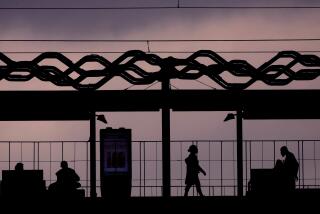Suit seeks to save Cocoanut Grove
In an effort to keep intact the landmark Cocoanut Grove nightclub at the former Ambassador Hotel, the Los Angeles Conservancy has again sued the Los Angeles Unified School District.
The suit, filed Thursday in Los Angeles County Superior Court, contends the district broke the law when it decided recently to demolish most of the Cocoanut Grove structure and asks a judge to require the school system to spare the nightclub or prove why it can’t. It also asks a judge to halt the project while a determination is made.
“We believe they need to be held accountable,” said conservancy Director Linda Dishman.
The school board, voting unanimously last month, relied on district staff’s supplemental environmental report, which said that those portions of the fabled nightclub were too weak to be feasibly shored up. The board gave the green light to replicate those structures and to slope the floor so that the room could be used as an auditorium when the hotel is turned into a new campus, among other changes.
“The conservancy would be a lot better off trying to sue to suspend the laws of gravity if they want the Cocoanut Grove” kept intact, said Kevin Reed, L.A. Unified’s general counsel.
He called the lawsuit frivolous and said the district “scrupulously” followed the law when it determined it needed to tear down the weaker parts of the structure.
The district plans to spend $341 million to build an elementary, middle and high school that will house 4,240 students on the site of the historic 1921 hotel.
The 24-acre property, once the glittering stamping ground of celebrities, presidents and other politicians, had been closed for more than a decade and was being sold in Bankruptcy Court in 2001 when the district snatched it up.
State law requires the district to conduct an environmental review before building a school. In addition to analyzing pollution at the site, the district is required to review the historical value of the buildings it plans to tear down. In its environmental impact report, the district acknowledged that the property was historically significant.
The district said most of the Ambassador was too weak to be remodeled. To mitigate tearing down most of the hotel, L.A. Unified said it would preserve the pantry where Sen. Robert F. Kennedy was assassinated in 1968 and keep the Cocoanut Grove, home to six Academy Awards shows, as a high school auditorium.
But under current plans -- approved during a public hearing in September -- only the east wall, the circular entry and a portion of the glass west wall of the nightclub and historic Paul Williams cafeteria will remain, along with some interior features that were removed and will be incorporated into the design.
As for the pantry, L.A. Unified decided in 2005 that the district would collect 29 items from it -- mostly doors, electrical items and an ice machine -- put them in storage and tear down the rest. Dishman said her group was not consulted before the move.
“They had made a commitment to preserve the pantry and incorporate it into the new school building, and instead they have disassembled it in 29 pieces,” Dishman said. “So this national historic site is reduced to Humpty Dumpty.”
The conservancy is also asking a judge to stop the district from taking any action on the artifacts from the hotel’s pantry.
A district-sponsored committee has recommended that the artifacts be destroyed, as the Kennedy family wished. In March, staff prepared a memorandum explaining how that could be done.
But the district has yet to determine what it will do with the artifacts, officials said.
If a judge grants a preliminary injunction, Reed said it would probably delay the construction of the schools.
The school site has pitted conservationists against neighborhood activists, who have been waiting for the K-12 campus for years to ease overcrowding in other neighborhood schools. Current plans call for completion of the K-3 building in 2009 and the remainder in 2010.
The conservancy and other preservation groups filed lawsuits to block the hotel’s destruction after the school board first approved it in 2004. In 2005, the conservancy enlisted state and national politicians in a failed, last-ditch effort at a compromise that would have turned the hotel’s main building into low-income apartments, around which school buildings would be constructed.
Soon after, a Los Angeles County Superior Court judge dismissed the conservation groups’ proposal. The conservancy agreed to drop that lawsuit in exchange for a $4.9-million contribution from the district to a nonprofit organization aimed at preserving historic school buildings.
--
More to Read
Sign up for Essential California
The most important California stories and recommendations in your inbox every morning.
You may occasionally receive promotional content from the Los Angeles Times.










